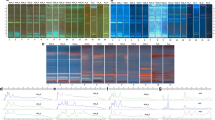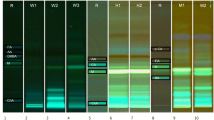Abstract
Using honey as a model sample, the aim of this study is to develop and validate a simple, rapid screening tool that allows for the visualization of constituents that contribute to the antioxidant activity of a complex natural product and to quantify their individual antioxidant effects even if their chemical identity is unknown. The method employs a validated analysis, which is based on the separation of constituents using high-performance thin-layer chromatography (HPTLC) followed by their visualization using DPPH* (2,2-diphenyl-1-picrylhydrazyl) as derivatizing reagent and the quantification of the antioxidant activity of individual bands expressed as gallic acid equivalents.





Similar content being viewed by others
References
Blois MS (1958) Antioxidant determinations by the use of a stable free radical. Nature 181(4617):1199–1200. https://doi.org/10.1038/1811199a0
Romanet R, Coelho C, Liu Y, Bahut F, Ballester J, Nikolantonaki M, Gougeon RD (2019) The antioxidant potential of white wines relies on the chemistry of sulfur-containing compounds: an optimized DPPH assay. Molecules 24(7):1353. https://doi.org/10.3390/molecules24071353
Shimoji Y, Tamura Y, Nakamura Y, Nanda K, Nishidai S, Nishikawa Y, Ishihara N, Uenakai K, Ohigashi H (2002) Isolation and identification of DPPH radical scavenging compounds in Kurosu (Japanese unpolished rice vinegar). J Agric Food Chem 50(22):6501–6503. https://doi.org/10.1021/jf020458f
Matsuura H, Chiji H, Asakawa C, Amano M, Yoshihara T, Mizutani J (2003) DPPH radical scavengers from dried leaves of oregano (Origanum vulgare). Biosci Biotechnol Biochem 67(11):2311–2316. https://doi.org/10.1271/bbb.67.2311
Mohamad H, Abas F, Permana D, Lajis NH, Ali AM, Sukari MA, Hin TY, Kikuzaki H, Nakatani N (2004) DPPH free radical scavenger components from the fruits of Alpinia rafflesiana Wall. ex. Bak. (Zingiberaceae). Z Naturforsch C 59(11–12):811–815. https://doi.org/10.1515/znc-2004-11-1208
Marxen K, Vanselow KH, Lippemeier S, Hintze R, Ruser A, Hansen UP (2007) Determination of DPPH radical oxidation caused by methanolic extracts of some microalgal species by linear regression analysis of spectrophotometric measurements. Sensors (Basel) 7(10):2080–2095. https://doi.org/10.3390/s7102080
Gawron-Skarbek A, Guligowska A, Prymont-Przyminska A, Nowak D, Kostka T (2018) Plasma and salivary non-urate total antioxidant capacity does not depend on dietary vitamin C, E, or beta-carotene intake in older subjects. Molecules 23(4):983. https://doi.org/10.3390/molecules23040983
Liang N, Kitts D (2014) Antioxidant property of coffee components: assessment of methods that define mechanisms of action. Molecules 19:19180–19208. https://doi.org/10.3390/molecules191119180
Kawabata J, Okamoto Y, Kodama A, Makimoto T, Kasai T (2002) Oxidative dimers produced from protocatechuic and gallic esters in the DPPH radical scavenging reaction. J Agric Food Chem 50(19):5468–5471. https://doi.org/10.1021/jf020347g
Kedare SB, Singh RP (2011) Genesis and development of DPPH method of antioxidant assay. J Food Sci Technol 48(4):412–422. https://doi.org/10.1007/s13197-011-0251-1
Matsufuji H, Kido H, Misawa H, Yaguchi J, Otsuki T, Chino M, Takeda M, Yamagata K (2007) Stability to light, heat, and hydrogen peroxide at different pH values and DPPH radical scavenging activity of acylated anthocyanins from red radish extract. J Agric Food Chem 55(9):3692–3701. https://doi.org/10.1021/jf063598o
Milardovic S, Ivekovic D, Grabaric BS (2006) A novel amperometric method for antioxidant activity determination using DPPH free radical. Bioelectrochemistry 68(2):175–180. https://doi.org/10.1016/j.bioelechem.2005.06.005
Rehakova Z, Koleckar V, Cervenka F, Jahodar L, Saso L, Opletal L, Jun D, Kuca K (2008) DPPH radical scavenging activity of several naturally occurring coumarins and their synthesized analogs measured by the SIA method. Toxicol Mech Methods 18(5):413–418. https://doi.org/10.1080/15376510701511448
Cheng Z, Moore J, Yu L (2006) High-throughput relative DPPH radical scavenging capacity assay. J Agric Food Chem 54(20):7429–7436. https://doi.org/10.1021/jf0611668
Villano D, Fernandez-Pachon MS, Moya ML, Troncoso AM, Garcia-Parrilla MC (2007) Radical scavenging ability of polyphenolic compounds towards DPPH free radical. Talanta 71(1):230–235. https://doi.org/10.1016/j.talanta.2006.03.050
Chen Z, Bertin R, Froldi G (2013) EC50 estimation of antioxidant activity in DPPH. assay using several statistical programs. Food Chem 138(1):414–420. https://doi.org/10.1016/j.foodchem.2012.11.001
Song HS, Bae JK, Park I (2013) Effect of heating on DPPH radical scavenging activity of meat substitute. Prev Nutr Food Sci 18(1):80–84. https://doi.org/10.3746/pnf.2013.18.1.080
Lebeau J, Furman C, Bernier JL, Duriez P, Teissier E, Cotelle N (2000) Antioxidant properties of di-tert-butylhydroxylated flavonoids. Free Radic Biol Med 29(9):900–912. https://doi.org/10.1016/s0891-5849(00)00390-7
Kim J-K, Abdel-Zaher NA, Lee S, Sue TACJ, Suh H, Young TACH, Ok TASY, Won-Chul TAC (2002) The first total synthesis of 2,3,6-tribromo-4,5-dihydroxybenzyl methyl ether (TDB) and its antioxidant activity (the first total synthesis of 2,3,6-tribromo-4,5-dihydroxybenzyl methyl ether (TDB) and its antioxidant activity). Bull Kor Chem Soc 23:661–662. https://doi.org/10.5012/BKCS.2002.23.5.661
Achat S, Rakotomanomana N, Madani K, Dangles O (2016) Antioxidant activity of olive phenols and other dietary phenols in model gastric conditions: scavenging of the free radical DPPH and inhibition of the haem-induced peroxidation of linoleic acid. Food Chem 213:135–142. https://doi.org/10.1016/j.foodchem.2016.06.076
Brand-Williams W, Cuvelier ME, Berset C (1995) Use of a free radical method to evaluate antioxidant activity. LWT Food Sci Technol 28(1):25–30. https://doi.org/10.1016/S0023-6438(95)80008-5
Yepez B, Espinosa M, López S, Bolaños G (2002) Producing antioxidant fractions from herbaceous matrices by supercritical fluid extraction. Fluid Phase Equilib 194-197:879–884. https://doi.org/10.1016/S0378-3812(01)00707-5
Ristivojevic P, Trifkovic J, Vovk I, Milojkovic-Opsenica D (2017) Comparative study of different approaches for multivariate image analysis in HPTLC fingerprinting of natural products such as plant resin. Talanta 162:72–79. https://doi.org/10.1016/j.talanta.2016.10.023
Amina M, Alam P, Parvez MK, Al-Musayeib NM, Al-Hwaity SA, Al-Rashidi NS, Al-Dosari MS (2018) Isolation and validated HPTLC analysis of four cytotoxic compounds, including a new sesquiterpene from aerial parts of Plectranthus cylindraceus. Nat Prod Res 32(7):804–809. https://doi.org/10.1080/14786419.2017.1363750
Ladda PL, Magdum CS (2018) Antitubercular activity and isolation of chemical constituents from plant Vitex negundo Linn. Iran J Pharm Res 17(4):1353–1360
Scotti F, Lobel K, Booker A, Heinrich M (2018) St. John’s Wort (Hypericum perforatum) products - how variable is the primary material? Front Plant Sci 9:1973. https://doi.org/10.3389/fpls.2018.01973
Chauhan S, Sharma A, Upadhyay NK, Singh G, Lal UR, Goyal R (2018) In-vitro osteoblast proliferation and in-vivo anti-osteoporotic activity of Bombax ceiba with quantification of Lupeol, gallic acid and beta-sitosterol by HPTLC and HPLC. BMC Complement Altern Med 18(1):233. https://doi.org/10.1186/s12906-018-2299-1
Agatonovic-Kustrin S, Morton DW, Yusof AP (2016) Development and validation of a simple high performance thin layer chromatography method combined with direct 1,1-diphenyl-2-picrylhydrazyl assay to quantify free radical scavenging activity in wine. Food Chem 197(Pt A):285–290. https://doi.org/10.1016/j.foodchem.2015.10.128
Agatonovic-Kustrin S, Morton DW, Ristivojevic P (2016) Assessment of antioxidant activity in Victorian marine algal extracts using high performance thin-layer chromatography and multivariate analysis. J Chromatogr A 1468:228–235. https://doi.org/10.1016/j.chroma.2016.09.041
Ibrahim RS, Khairy A, Zaatout HH, Hammoda HM, Metwally AM (2018) Digitally-optimized HPTLC coupled with image analysis for pursuing polyphenolic and antioxidant profile during alfalfa sprouting. J Chromatogr B Anal Technol Biomed Life Sci 1099:92–96. https://doi.org/10.1016/j.jchromb.2018.09.021
Wang L, Chen YS, Ye ZY, Hellmann B, Xu XM, Jin ZY, Ma QQ, Yang N, Wu FF, Jin YM (2018) Screening of phenolic antioxidants in edible oils by HPTLC-DPPH assay and MS confirmation. Food Anal Methods 11(11):3170–3178. https://doi.org/10.1007/s12161-018-1295-x
Anand S, Pang E, Livanos G, Mantri N (2018) Characterization of physico-chemical properties and antioxidant capacities of bioactive honey produced from Australian grown Agastache rugosa and its correlation with colour and poly-phenol content. Molecules 23(1):108. https://doi.org/10.3390/molecules23010108
Chepulis L (2015) Honey – food or medicine? The how, where, and why of bioactivity testing. Bee World 92(4):112–115. https://doi.org/10.1080/0005772X.2016.1152847
Khan FR, Ul Abadin Z, Rauf N (2007) Honey: nutritional and medicinal value. Int J Clin Pract 61(10):1705–1707. https://doi.org/10.1111/j.1742-1241.2007.01417.x
Mandal MD, Mandal S (2011) Honey: its medicinal property and antibacterial activity. Asian Pac J Trop Biomed 1(2):154–160. https://doi.org/10.1016/s2221-1691(11)60016-6
Molan P (2001) Why honey is effective as a medicine. Bee World 82(1):22–40. https://doi.org/10.1080/0005772X.2001.11099498
Di Marco G, Gismondi A, Panzanella L, Canuti L, Impei S, Leonardi D, Canini A (2018) Botanical influence on phenolic profile and antioxidant level of Italian honeys. J Food Sci Technol 55(10):4042–4050. https://doi.org/10.1007/s13197-018-3330-8
Payet B, Shum Cheong Sing A, Smadja J (2005) Assessment of antioxidant activity of cane brown sugars by ABTS and DPPH radical scavenging assays: determination of their polyphenolic and volatile constituents. J Agric Food Chem 53(26):10074–10079. https://doi.org/10.1021/jf0517703
Singh N, Sharma R, Balapure AK (2007) pH regulated scavenging activity of beer antioxidants through modified DPPH assay. Toxicol Ind Health 23(2):75–81. https://doi.org/10.1177/0748233707077429
Gul A, Pehlivan T (2018) Antioxidant activities of some monofloral honey types produced across Turkey. Saudi J Biol Sci 25(6):1056–1065. https://doi.org/10.1016/j.sjbs.2018.02.011
Locher C, Neumann J, Sostaric T (2017) Authentication of honeys of different floral origins via high-performance thin-layer chromatographic fingerprinting. J Planar Chromatogr Mod TLC 30(1):57–62. https://doi.org/10.1556/1006.2017.30.1.8
Locher C, Tang E, Neumann J, Sostaric T (2018) High-performance thin-layer chromatography profiling of Jarrah and Manuka honeys. J Planar Chromatogr Mod TLC 31(3):181–189. https://doi.org/10.1556/1006.2018.31.3.1
Stanek N, Jasicka-Misiak I (2018) HPTLC phenolic profiles as useful tools for the authentication of honey.(report). Food Anal Methods 11(11):2979–2989. https://doi.org/10.1007/s12161-018-1281-3
Borman P, Elder D (2017) Q2(R1) Validation of Analytical Procedures: Text and Methodology. In A Teasdale, D Elder and RM Nims (Eds) ICHQuality Guidelines: An Implementation Guide. John Wiley & Sons, Brisbane (pp. 127-166).
Agatonovic-Kustrin S, Kustrin E, Gegechkori V, Morton DW (2019) High-performance thin-layer chromatography hyphenated with microchemical and biochemical derivatizations in bioactivity profiling of marine species. Mar Drugs 17(3):148. https://doi.org/10.3390/md17030148
Zhang YZ, Wang S, Chen YF, Wu YQ, Tian J, Si JJ, Zhang CP, Zheng HQ, Hu FL (2019) Authentication of Apis cerana honey and Apis mellifera honey based on major royal jelly protein 2 gene. Molecules 24(2):289. https://doi.org/10.3390/molecules24020289
Agatonovic-Kustrin S, Hettiarachchi CG, Morton DW, Razic S (2015) Analysis of phenolics in wine by high performance thin-layer chromatography with gradient elution and high resolution plate imaging. J Pharm Biomed Anal 102:93–99. https://doi.org/10.1016/j.jpba.2014.08.031
Alvarez-Suarez JM, Gasparrini M, Forbes-Hernández TY, Mazzoni L, Giampieri F (2014) The composition and biological activity of honey: a focus on Manuka honey. Foods 3(3):420–432. https://doi.org/10.3390/foods3030420
Acknowledgements
We thank Chromatech Scientific for their technical support of this project.
Funding
This research was supported by funding from the Cooperative Research Centre for Honey Bee Products (Project 13) and the use of samples from AgriFutures Australia (PRJ-010313).
Author information
Authors and Affiliations
Corresponding author
Additional information
Publisher's note
Springer Nature remains neutral with regard to jurisdictional claims in published maps and institutional affiliations.
Electronic supplementary material
ESM 1
(DOCX 14.1 kb)
Rights and permissions
About this article
Cite this article
Islam, M.K., Sostaric, T., Lim, L.Y. et al. Development and validation of an HPTLC–DPPH assay and its application to the analysis of honey. JPC-J Planar Chromat 33, 301–311 (2020). https://doi.org/10.1007/s00764-020-00033-0
Received:
Accepted:
Published:
Issue Date:
DOI: https://doi.org/10.1007/s00764-020-00033-0




